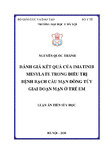
Please use this identifier to cite or link to this item:
http://dulieuso.hmu.edu.vn/handle/hmu/2095| Title: | Đánh giá kết quả của Imatinib Mesylate trong điều trị bệnh bạch cầu mạn dòng tủy giai đoạn mạn ở trẻ em. (Ngày công bố: 09/02/2021) |
| Authors: | Nguyễn Quốc, Thành |
| Advisor: | PGS.TS. Huỳnh, Nghĩa TS. Trần Thị Kiều, My |
| Keywords: | 62720151;Huyết học và truyền máu |
| Abstract: | Những kết luận mới của luận án: . 1. Đây là nghiên cứu đầu tiên ở Việt Nam nghiên cứu về kết quả điều trị của Imatinib Mesylate trong điều trị bệnh Bạch cầu mạn dòng tủy giai đoạn mạn ở trẻ em.. 2. Kết quả từ nghiên cứu cho thấy: Imatinib Mesylate giúp đạt được hiệu quả cao về đáp ứng điều trị, kéo dài thời gian sống với độc tính tối thiểu và mang lại một cuộc sống khỏe mạnh cho bệnh nhi Bạch cầu mạn dòng tủy giai đoạn mạn.. - Đáp ứng điều trị: 97,9% bệnh nhân đạt đáp ứng huyết học hoàn toàn khi điều trị bằng Imatinib Mesylate; tỉ lệ đạt đáp ứng tốt di truyền tế bào là 96,9%; tỉ lệ đạt đáp ứng hoàn toàn di truyền tế bào là 87,5%; tỉ lệ đạt đáp ứng tốt sinh học phân tử là 78,1%. Qua phân tích đa biến: phân nhóm nguy cơ theo Sokal yếu tố liên quan đến đáp ứng điều trị. Có 18,8% bệnh nhi xảy ra tình trạng kháng thuốc.. - Thời gian sống còn: sau 13 năm, tỉ lệ sống không biến cố là 75,5%, tỉ lệ sống không tiến triển bệnh là 97,6%, tỉ lệ sống toàn bộ là 97,9%. Qua phân tích đa biến, yếu tố ảnh hưởng đến thời gian sống là đạt MMR và nhóm nguy cơ Sokal.. Độc tính của Imatinib Mesylate thường ở mức độ nhẹ - trung bình và có thể kiểm soát được. Độc tính huyết học thường gặp nhất là giảm tiểu cầu (25%) tiếp theo là giảm bạch cầu hạt (15,6%) và thiếu máu (5,2%). Độc tính không phải huyết học thường gặp nhất là đau khớp (13,6%), co cứng cơ và nôn (9,4%). Có 42,5% trẻ có chiều cao thấp hơn so với chiều cao theo tuổi. Không ghi nhận trường hợp tử vong do thuốc. Novelties of the study:. 1. This is the first study in Vietnam regarding the assessment of IM’s effectiveness in pediatric CML in chronic phase.. 2. The study showed that: IM was associated with high response rate, which helps extend patients’ survival with minimal toxicities and maintain the well-being for pediatric CML patients in chronic phase.. - Response rate: 97,9% of patients on IM achived complete hematological response (CHR); the rate of major cytogenetic response (McyR), complete cytogenetic response (CcyR), and major molecular response (MMR) were 96.9%, 87.5%, and 78.1%, respectively. The multivariable analysis revealed that risk stratification according to Sokal was related to response rate. Resistance was found in only 18.8% of patients.. - Survival duration: after 13 years of follow-up, the event-free survival rate, the progression-free survival rate and the overall survival rate were 75.5%, 97.6%, and 97.9%, respectively. The multivariable analysis revealed that risk stratification according to Sokal and MMR achievement were the 2 factors associated with survival.. The toxicities of IM were often of mild – moderate manifestations and can be manageable. The most frequently seen hematologic toxicity was thrombocytopenia (25%) followed by neutropenia (15.6%). Anemia accounted for only 5.2% of cases. The most common non-hematologic adverse effects were arthralgia (13.6%), muscle cramps and vomiting (9.4%). There were 42.5% of cases whose height was less than normal range. No drug-induced deaths were recorded. |
| URI: | http://dulieuso.hmu.edu.vn//handle/hmu/2095 |
| Appears in Collections: | Luận án (nghiên cứu sinh) |
Files in This Item:
| File | Description | Size | Format | |
|---|---|---|---|---|
| 595_00_TVLAthanh35HHTM.pdf Restricted Access | 7.91 MB | Adobe PDF |  Sign in to read | |
| 595_TTLAthanh35HHTM.zip Restricted Access | 1.74 MB | Zip Compressed Archive |
Items in DSpace are protected by copyright, with all rights reserved, unless otherwise indicated.